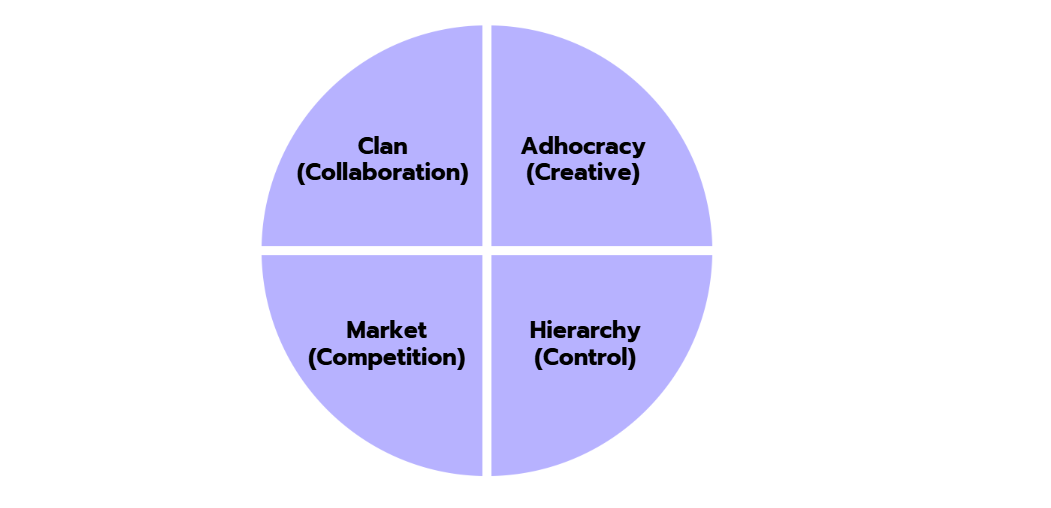The Competing Values Framework (CVF) is a robust model that helps organizations better understand, assess, and ultimately transform their cultures.
The Competing Values Framework was developed in the 1980s. It began with a research study by Robert Quinn, John Rohrbaugh, and other colleagues aimed at identifying key indicators of organizational effectiveness. They conducted a factor analysis of existing organizational assessments and identified two main dimensions that formed the basis for the framework: internal vs. external and flexibility vs. control.
Quinn is co-founder of the Center for Positive Organizations at the Ross School of Business. His research has helped advance the concepts of positive organizational science, which focuses on strengthening and improving organizations by building positive attributes, rather than focusing only on fixing deficits. John Rohrbaugh is a professor in the Rockefeller College of Public Affairs and Policy at the University at Albany, State University of New York. His research interests are in strategic management, organizational behavior, and decision-making.
Developed in the 1980s by Robert Quinn and John Rohrbaugh, the CVF has served as a prism for studying organizations.
How Can the Competing Values Framework (CVF) Help to Transform Organisational Cultures?
The CVF divides organizational cultures into four main quadrants: Clan, Adhocracy, Market, and Hierarchy. These quadrants reflect the tensions between internal and external factors, and between stability and control on the one hand and flexibility and change on the other.

- Clan (Collaboration) - "Doing things together" / Long-Term Development:
Clan culture is characterized by strong internal focus and flexibility. It is characterized by collaboration, participation and communication. The clan quadrant is often described as an extended family where employees feel a high degree of loyalty and belonging. In this culture, the main activities are often focused on teamwork, consensus building, and internal harmony. The main purpose is to create a harmonious work environment where employees feel comfortable and can best utilize their skills. The typical type of employee in a Clan culture is team-oriented, more loyal, and maintains strong personal relationships in the workplace. - Adhocracy (Creative) - "Doing things first" / Innovations:
Adhocracy is characterized by a high degree of flexibility and external focus. In this culture, innovation is at the core and there is a dynamic and entrepreneurial atmosphere. Main activities in Adhocracies are experimentation, risk taking and adaptation to change. The purpose of such a culture is to achieve competitive advantage through innovation and creativity. The typical type of employee is creative, entrepreneurial, and willing to take risks. - Market (Competition) - "Do things quickly" / Short-Term Performance:
The Market focuses on external factors, with a high priority on stability and control. This culture emphasizes competitiveness, results orientation, and performance. The main activities in Market cultures focus on transactions, competition, and achieving market goals. The purpose of this culture is to achieve market dominance through superior performance. The typical type of employee in a Market culture is results-oriented, goal-oriented, and competitive. - Hierarchy (Control) - "Doing things right" / Working incrementally:
The Hierarchy culture emphasizes internal factors and values stability and control. Here, the emphasis is on order, rules, and uniform procedures. The main activities in Hierarchical cultures involve coordination, organization, and efficiency. The main purpose is to ensure smooth operations and reliable performance. The typical type of employee in a hierarchical culture values consistency, order, and structure.
Benefits and Possible Applications for Consultants
For consultants, the CVF provides a precise tool for analyzing their clients' organizational culture. It helps them understand their clients' current strengths and weaknesses, plan relevant changes, and design effective interventions.
Knowledge of organizational culture can also help consultants develop customized solutions that meet the organization's specific needs and priorities. By using the CVF, they can determine, for example, whether an organization is willing to take risks and embrace innovation, or whether it values stability and control more.
In addition, consultants can use the CVF to assess the impact of change on the organization. They can predict how a change will affect the existing culture and how to shape the change initiative to meet the needs and priorities of the organization.
Overall, the Competing Values Framework provides a comprehensive map of organizational culture. It provides consultants with a clear path to understand and navigate the often-nebulous aspects of culture, and it provides an effective framework for designing and implementing change. It is an indispensable tool to help consultants help their clients adapt to an ever-changing business environment.

